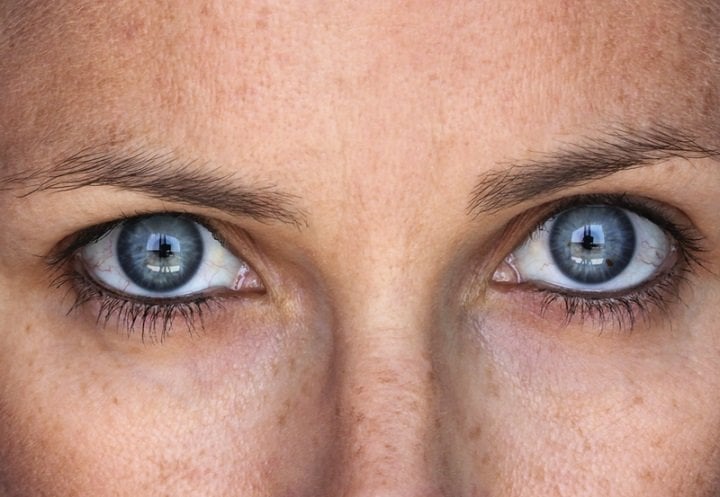6 Natural Ways to Repair Sun-Damaged Skin

It’s summertime, the sun is shining, and you’re spending more time outside—even if it’s just on a morning walk or walking from and to your car at the grocery store (make sure to park farther away to get in some extra steps). You know your skin has been damaged if you experience a sunburn, but it can also be damaged with little incidental exposure over the years. And that ultraviolet (UV) exposure is the culprit behind around 80% of skin aging. Fortunately, it is possible to repair sun-damaged skin, at least to some degree.
If you are someone who rarely goes outside and wears sunscreen all day, every day, you likely don’t need to worry that much about sun damage. (Though it’s probably a good idea to learn more about the importance of non-burning sun exposure and ensuring you have healthy vitamin D levels as it’s really not healthy to avoid all exposure to the sun, which can actually increase the risk of early death. 1)
Many more of us, though, love spending time outdoors, enjoying nature and fun in the sun. And especially when you’re young, sunscreen can be an afterthought—only considered after the skin turns pink, or more likely, red.
Maybe you do remember to slather on the sunscreen when heading out for several hours, yet you don’t think about it on a daily basis. Yet much of time, sun exposure is incidental. In fact, 75% of sun exposure happens as we’re running errands, picking up mail, or doing usual activities.
And for the most part, the damage you’re doing now isn’t even noticeable. For example, if you spent a lot of time in the sun in your teens and 20s, the accumulated damage didn’t start to become visible until you reached your late 30s, 40s, or 50s.
Fortunately, even if you’ve started to see the signs of sun damage—like wrinkles, freckles and dark spots, leathery skin, or moles—it’s not too late to naturally protect (and even repair) sun-damaged skin.
What Is Sun Damage?
Your skin absorbs UV light from the sun, tanning beds, and even through windows. If you are overexposed to UV light, it can begin to damage the DNA in the skin’s cells. And that damage is cumulative throughout life, starting with childhood sun exposure.
As the skin is continually exposed throughout the years, it can damage the structure of the skin in a process known as “oxidative photodamage.” This damage appears as:
- Sunburn
- Tanning (Yes, tanning is sun damage!) 2
- Dry skin, which looks ashy, flaky, or rough
- Bumps
- Age spots (aka liver spots, brown spots, or hyperpigmentation) due to uneven distribution or “clumping” of melanin
- Freckles
- Moles
- Rosacea
- Thinning, more translucent skin
- Fine lines, wrinkles, and thinning skin (due to the breakdown of collagen and elastin)
- Dry, scaly patches caused by actinic keratosis, which can later lead to skin cancer
- Leathery-looking skin
- Sagging or drooping skin and a loss of elasticity
- Growth of blood vessels and broken capillaries
The end result of sun damage is lines, wrinkles, dullness, uneven skin tone, and dwindling firmness (i.e., premature aging). 3
According to one study, UV rays were to blame for 80.3% of skin aging in a group of white women from the ages of 30 to 78 years old. 4 If you are blessed with more melanin (and thus have darker skin pigmentation), that doesn’t mean you aren’t at risk for sun damage, though. Melanin does help protect against UV damage, as it absorbs broadband UV, and it also has antioxidant and free-radical-scavenging properties, so it’s generally believed to be perfect protection against UV-induced skin damage. 5 Yet people with darker skin can still experience sun damage, including sunburns and common skin cancers.
Sadly, because of the lack of research and understanding between skin color and skin cancer, when black people are found to have skin cancer, it’s usually at a later, more advanced stage. Studies have found, for example, that black people are 4 times more likely to receive an advanced stage melanoma diagnosis and are 1 ½ times less likely to survive compared to their white counterparts. 6
No matter where you fall on the color spectrum, sun damage can occur. Don’t fall for the “magic of melanin” from either a darker natural skin tone or a deep tan and think sun protection (e.g., sunscreen) isn’t warranted.
Dermatologists recommend using an SPF of 30 to 50 to help protect against sun damage. Darker skin, on the other hand, provides a natural protection of just up to 13 SPF, and it does not appear to protect against UVA rays the same way it protects against UVB rays. 5 Melanin levels are also not consistent throughout the body, leaving parts of your skin more vulnerable.
To really protect your skin, if you’re going to be outside for extended times (e.g., exercising, hiking, or gardening), along with your sunscreen, put on a wide-brimmed hat and don’t forget sunglasses.
Can You Repair Sun-Damaged Skin?
As the adage goes, “An ounce of prevention is worth a pound of cure.” Your skin is always in the process of either being created or destroyed, so you want to head off the damage the sun can cause before it has a chance to do its worst. Sunscreen is the best way to protect against sun damage now and in the future. It may even help prevent skin cancer.
Here’s how to safely chose, use, and properly apply sunscreen.
Don’t just use sunscreen on sunny days, though. Up to 95% of the sun’s UVA rays (the most damaging type of UV rays) hit the surface of the earth, and that includes on cloudy days as well as through windows. Because your face is almost always exposed, many dermatologists recommend applying a quarter teaspoon of 30 to 50 SPF sunscreen to the face every morning as a preventive measure. Even among folks who already apply sunscreen daily, they rarely use this much. (If in doubt, try measuring it out to see how much you’ve been using.)
That said, your skin is also working hard to repair sun-damaged skin from previous sun exposure. And reducing harmful amounts of sun exposure by regularly using sunscreen correctly can help it do its job by giving the skin time to heal and the immune system time to repair DNA damage.
6 Ways to Repair Sun-Damaged Skin
Is there anything else you can do to help your skin repair? The answer is a resounding yes! Here’s how:
Improve skin texture with exfoliation
Exfoliating the skin just means you’re removing the old dead skin cells that sit on the surface of your skin. It can also increase circulation and encourage skin turnover. Gentle exfoliation once to twice a week can help the skin look softer, smoother, brighter, and more beautiful as well as open up the skin to breathe, which allows it to better absorb moisturizing serums.
For your body, you can use store-bought loofahs, brushes, sponges, or even gloves. Or, you can use an exfoliating cream. (You can even make your own with used coffee grounds.) Make sure you use small, circular motions if you’re using a cream and light, short strokes if you use a brush or loofah. And keep your touch gentle to avoid damaging the skin.
If you have sensitive skin, you may want to avoid scrubbing to exfoliate as this can irritate the skin and cause inflammation. In that case, choose a gentle chemical exfoliator. On the other hand, skin that’s oilier may benefit more from manual exfoliation. Avoid exfoliating your skin if it’s red, inflamed, peeling, or irritated. Exfoliation should also be avoided if you are using certain medications (e.g., retinol) or acne products (e.g., benzoyl peroxide).
It takes just about 30 seconds to exfoliate each body part. Then make sure you rinse off the dead skin with warm (not hot!) water. You’ll also want to avoid exfoliating damaged skin (i.e., skin that’s injured or sunburned). Then top off with a quality moisturizer before you head into your day.
It’s worth noting that some exfoliating creams can contain ingredients like glycolic acid and vitamin E, which make the skin more sensitive to the sun. So, if you are using products like that, you will also want to make sure you apply sunscreen before being exposed to the sun.
Soak up some steam (no more than once a week)
For a really deep, detoxifying clean, you can enjoy a steam facial. This DIY beauty treatment is simple, quick, and will leave you feeling refreshed. Plus, steaming your skin:
- Is cleansing, as it opens up pores and loosens the buildup of dirt, so you can clean your skin more deeply, releasing dead cells, bacteria, and impurities that could be clogging pores.
- Promotes circulation by dilating the blood vessels to increase blood flow to nourish and oxygenate the skin.
- Loosens trapped sebum to help prevent acne and blackheads.
- Deeply hydrates the skin by increasing the natural production of your own oils to moisturize from the inside out.
- Increases permeability, so you can better absorb topical moisturizers.
- Promotes collagen and elastin production by increasing blood flow.
- Is relaxing and soothing, especially if you add calming fruits, herbs, or essential oils.
- Is simple, easy, and affordable.
Begin by using a gentle cleanser (and perhaps exfoliator), so your skin can fully benefit from your steam session.
Then, fill a large bowl with hot, even boiling, water (please don’t burn yourself) and add the peels from lemon, lime, or an orange—alternatively or in addition, you can add a few drops of a citrus essential oil or even some green or herbal tea. The citrus, for example, provides antioxidants to nourish your skin, and it’s also an uplifting scent that may energize you and improve mood.
Now close your eyes and place your face over the bowl (far enough away so there’s no risk of being burned by the steam yet you can still feel it moisturizing your skin—about six to ten inches away) and drape a towel over your head to keep the steam in. Comfort is key here. Avoid allowing your skin to get too warm as a steam burn can lead to more damage. In other words, listen to your skin and back off if your steam session isn’t completely comfortable and relaxing.
Make sure you’re sitting comfortably so you can relax and just breathe with your eyes closed for the next five to ten minutes (no more) as your skin rehydrates and your senses rejoice. Then follow up your steam session by rinsing your face with cool or lukewarm water to help close up the pores and prevent pollutants from getting back into your skin. Pat dry and moisturize as usual.
Caveat: If your skin is red, irritated, or you have rosacea, skip the steam session until your skin is no longer irritated.
Lock in the moisture
After cleansing, exfoliating, or steaming your skin, you’ll want to ensure you lock in some moisture with a quality serum or lotion that’s loaded with antioxidants and other skin-nourishing botanicals. Even oily skin benefits from a quality moisturizing lotion or serum.
To deeply hydrate the skin, some of our favorite ingredients include:
- Sodium Hyaluronate, which moisturizes, hydrates, and helps plump the appearance of skin.
- Squalane, which is one of nature’s truly great moisturizers to hydrate the skin as well as help it absorb other skin-nourishing ingredients.
- Bellis perennis (Daisy) flower, which helps even skin tone and improve pigmentation to improve skin brightness and reduce the appearance of age spots.
- DermalRx SRC, which naturally exfoliates to loosen keratinized cells and stimulate skin renewal.
- Niacinamide, which helps protect and repair the skin from UV damage.
- Brightenyl, which can help restore even skin tone and reduce the appearance of dark spots and restore the skin’s natural tone.
- B-White, which has been shown to reduce the appearance of age spots on the hands and neck after as little as two weeks.
- And Gwennis, which helps support healthy melanin metabolism and may help reduce skin pigmentation to decrease the appearance of age spots.
For a simple, easy, and convenient ageless beauty routine, Ageless Glow® and Ageless Bright® provide all of these skin-nourishing nutrients and more. Simply apply Ageless Glow first, let it dry, and then apply Ageless Bright.
Consume antioxidant-rich foods
You’ll want to nourish your skin both from the outside and the inside by ensuring your diet is rich in foods that provide free-radical savaging antioxidants like:
- Blueberries
- Grapes
- Red berries
- Dark green vegetables
- Artichokes
- Orange vegetables, like carrots and squash, which are high in beta-carotene
- Cabbage
- Beets
- Tomatoes and watermelon, which are high in lycopene
- Nuts, which provide omega-3 fatty acids
- Green tea, which provides the catechin EGCG
UV rays have been shown to destroy many of the nutrients important to skin health, so while they can’t completely reverse skin damage, foods high in antioxidants may help battle aging signs, boost skin health, and help repair sun-damaged skin.
One of the most well-known antioxidants, Vitamin C, for example, helps encourage collagen production, which is why it’s included in BioTRUST’s Ageless Collagen Booster™. The B vitamins niacin and biotin are also known for helping promote healthy hair, skin, and nails. Vitamin E is also a potent antioxidant that may help reduce sun damage and support healthy skin texture. Omega-3 fatty acids, such as those found in fatty fish, chia seeds, flax seeds, and omega-3 supplements like OmegaKrill 5X™, may also help the skin look more plump, youthful, and hydrated by providing essential fats.
Stay hydrated
Very few of us get the water we need to keep our skin (and our bodies, for that matter) healthy. The Institute of Medicine recommends consuming between 91 and 125 ounces of fluid daily, depending on gender, weight, climate, and health status, to stay hydrated. That’s up to 15 ½ cups a day, which seems like a lot, but it includes not just the water you sip on throughout the day but the water found in the foods you eat and the other liquids you consume.
If we don’t stay hydrated, it can hinder our waste removal, making it more difficult to flush out toxins and potentially slowing skin healing and regeneration. Don’t just slam a bunch of water first thing in the morning, though. The body needs a steady flow of hydrating liquids throughout the day.
To really ensure you’re staying hydrated, you’ll also want to reduce your consumption of alcohol, sugary drinks, and caffeine, as these substances can dehydrate the body.
Get your beauty sleep
It’s called beauty sleep for good reason! If you want to begin to lose those aging dark circles under your eyes or droopy eyelids… if you want to improve your skin tone to look brighter and more vibrant… if you want to reduce the appearance of fine lines and wrinkles… if you want to repair sun-damaged skin… you need to prioritize a good night’s sleep of seven to eight hours every night (as much as possible). 7
As you rest, your skin cells get down to the hard work of repairing and generating collagen and increasing blood flow. This process, in turn, helps lift skin and prevent sagging, plump up to look fuller and more youthful, and improve completion.
According to research, it’s important to get to sleep before 11:00 p.m. as between 11:00 and midnight is when “cell mitosis” or the process of repairing and renewing skin occurs whether you’re asleep or awake. Your cells require nutrients and rest to have the greatest effects on the repair and appearance of your skin.
In addition, as you sleep deeply, levels of growth hormone increase, which is also needed for the repair and renewal of skin cells.
Within a month of making quality sleep a priority, you can start to see results as your skin sheds old, damaged cells and makes new ones. It makes sense that nighttime is also when you can get the best results from skin serums, as the skin can soak up the topical nourishment to better do its job.
Repair Sun-Damaged Skin: A Recap
Sadly for our skin, we can’t go back in time and undo those beach-day sunburns of our youth or the incidental damage caused simply by everyday activities, but we can help prevent future damage and even help repair sun-damaged skin with the tools and strategies above.
Remember, though, what you do today affects how you’ll look 5, 10, 20, and 30+ years in the future, so it’s worth making the effort to wear sunscreen, enjoy antioxidant-rich foods, supply your skin with nutrients needed for repair with a quality skin serum, keep an eye on any skin changes, and visit your doctor or dermatologist yearly to ensure this vital organ is as healthy and fit as possible.







